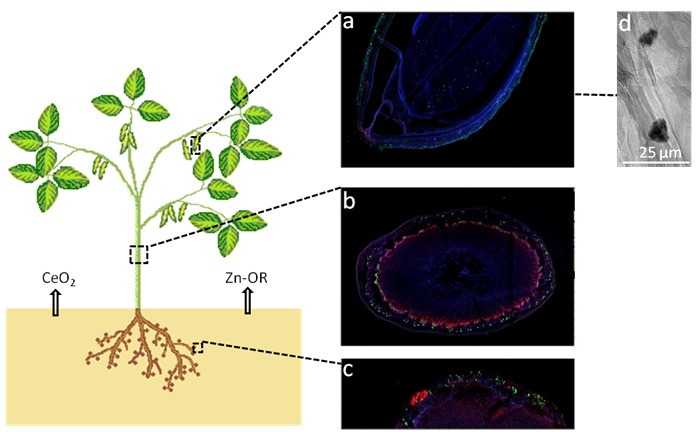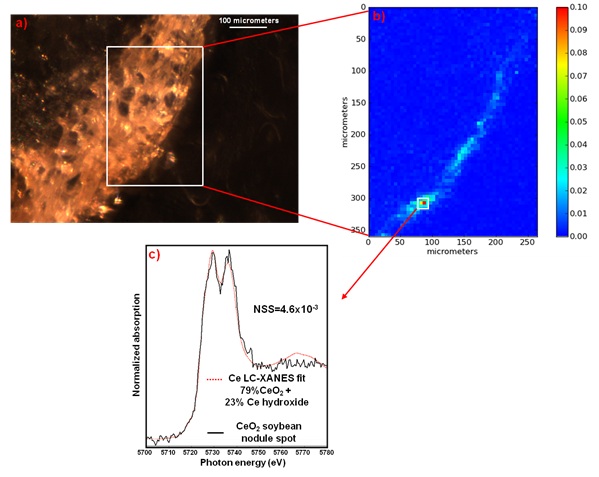The global production of engineered nanoparticles (ENPs) is currently a trillion-dollar industry. However, ENPs behave differently than their bulk counterparts, mostly due to increased specific surface area and reactivity, which has raised concerns about their fate, transport, and toxicity in the environment. A growing number of products containing ENPs are already on the market, including ZnO nanoparticles widely used sunscreen, gas sensors, pigments and other applications, and nanoceria (Ce ENPs) used as catalysts for internal combustion and oil cracking processes. The potential storage of these ENPs or their biotransformed products in edible/reproductive organs of crop plants can allow them to enter the food chain and the next plant generation.
Because terrestrial plants are part of the first trophic level, it is important to study their interactions with ENPs and the possible translocation of ENPs into the food chain1. Previously, Priester et al. determined the effects of ENP exposure on Ce and Zn accumulation and growth parameters of soybean (Glycine max) plants grown in farm soil amended with the previously mentioned ENPs2. However, important questions remain in studying the relationship of crop plants and ENPs, including the determination of their entrance into the food chain, their biotransformation, toxicity, and the possible persistence of these products into the next plant generation.
This report, recently published in ACS Nano by scientists from the University of Texas El Paso, UC Santa Barbara, ESRF and SSRL, studied ENP uptake in soybean plants which is the fifth-largest crop in global agricultural production and second-largest in the U.S. SSRL Beam Lines 2-3, 7-3, 10-2 and 6-2c and ESRF Beam Line ID21 were fundamental in addressing the above issues. Soybean plants grown to maturity in ZnO and CeO2 ENP-impacted soils were studied with μ-XRF and μ-XANES and full-field transmission X-ray microscopy (TXM). The chemical forms of Ce and Zn within various parts of the soybean and possible transfer of the ENPs into the food chain were reported.

When studying soybeans exposed to ZnO ENPs at SSRL, Zn was detected in the nodule, stem and pod (Figure 1) in concentrations higher than the control. Micro-XRF also showed that in the stem, Zn was translocated through the phloem (Figure 1b). μ-XANES analysis did not find any Zn bound in the form of ZnO ENPs in the plant, suggesting biotransformation of the ENPs. Furthermore, Zn precipitates in the pod were visualized at 30 nm resolution with TXM (Figure 1d). Linear combination fitting of XANES spectra collected on these precipitates suggests that Zn in soy is most likely bound to organic acids such as citrate. The presence of Ce in the nodule and its translocation to the pod was corroborated by μ-XRF at the ESRF. By comparing Ce L(III) μ-XANES spectra from high-intensity spots with model compounds (Figure 2), linear combination fitting showed that most of the Ce in the nodule and pod persisted as CeO2 ENPs.

These X-ray studies have provided insight into the fate and transport of ENPs in soybean plants.
To our knowledge, this is the first time that the transformation of Zn from ZnO nanoparticles in soil grown soybean pods has been reported. In addition, our results have shown that CeO2 ENPs in soil can be taken up by food crops and are not biotransformed in soybeans. This suggests that CeO2 ENPs can reach the food chain and the next soybean plant generation, with potential health implications.
- C. Rico, S. Majumdar, M. Duarte-Gardea, J. R. Peralta-Videa, and J. L. Gardea-Torresdey, “Interaction of Nanoparticles with Edible Plants and Their Possible Implications in the Food Chain”, J. Agric. Food Chem. 59, 3485–3498 (2011)
- J. H. Priester, Y. Ge, R. Mielke, A. M. Horst, S. Cole Moritz, K. Espinosa, J. Gelb, S. L. Walker, R. M. Nisbet, Y. J. An, et al. “Soybean Susceptibility to Manufactured Nanomaterials with Evidence for Food Quality and Soil Fertility Interruption”, Proc. Natl. Acad. Sci. U.S.A. www.pnas.org/cgi/doi/10.1073/pnas.1205431109
J. A. Hernandez-Viezcas, H. Castillo-Michel, J. C. Andrews, M. Cotte, C. Rico, J. R. Peralta-Videa,Y. Ge, J. H. Priester, P. A. Holden, and J. L. Gardea-Torresdey, "In Situ Synchrotron X‑ray Fluorescence Mapping and Speciation of CeO2 and ZnO Nanoparticles in Soil Cultivated Soybean (Glycine max)", ACS Nano (2013), [doi: 10.1021/nn305196q]




